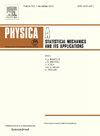Testing the generalized conjugate field formalism in the kinetic Ising model with nonantisymmetric magnetic fields: A Monte Carlo simulation study
IF 3.1
3区 物理与天体物理
Q2 PHYSICS, MULTIDISCIPLINARY
Physica A: Statistical Mechanics and its Applications
Pub Date : 2025-06-21
DOI:10.1016/j.physa.2025.130767
引用次数: 0
Abstract
We perform Monte Carlo simulations for the investigation of dynamic phase transitions (DPT) on a honeycomb lattice which has garnered a significant amount of interest from the viewpoint of tailoring the intrinsic magnetism in two-dimensional materials. For the system under the influence of time-dependent magnetic field sequences exhibiting the half-wave anti-symmetry, we have located a second order dynamic phase transition between dynamic ferromagnetic and dynamic paramagnetic states. Particular emphasis was devoted to the examination of the generalized conjugate field formalism previously introduced in the kinetic Ising model [1], [2]. Based on the simulation data, in the presence of a second magnetic field component with amplitude and period , the half-wave anti-symmetry is broken and the generalized conjugate field formalism is found to be valid for the present system. However, dynamic phase transitions disappear with the manifestation of a dynamically field polarized state for non-vanishing values.
具有非反对称磁场的动力学Ising模型的广义共轭场形式检验:蒙特卡罗模拟研究
我们对蜂窝晶格上的动态相变(DPT)进行了蒙特卡罗模拟研究,从定制二维材料的固有磁性的角度来看,蜂窝晶格已经获得了大量的兴趣。对于具有半波反对称性的随时间磁场序列影响下的系统,我们找到了动态铁磁态和动态顺磁态之间的二阶动态相变。特别强调了先前在动力学Ising模型[1],[2]中引入的广义共轭场形式的检验。根据仿真数据,在振幅为H2、周期为P/2的第二磁场分量存在的情况下,打破了半波的不对称,证明了广义共轭场的形式对该系统是有效的。而H2值不消失时,动态相变消失,表现为动态场极化态。
本文章由计算机程序翻译,如有差异,请以英文原文为准。
求助全文
约1分钟内获得全文
求助全文
来源期刊
CiteScore
7.20
自引率
9.10%
发文量
852
审稿时长
6.6 months
期刊介绍:
Physica A: Statistical Mechanics and its Applications
Recognized by the European Physical Society
Physica A publishes research in the field of statistical mechanics and its applications.
Statistical mechanics sets out to explain the behaviour of macroscopic systems by studying the statistical properties of their microscopic constituents.
Applications of the techniques of statistical mechanics are widespread, and include: applications to physical systems such as solids, liquids and gases; applications to chemical and biological systems (colloids, interfaces, complex fluids, polymers and biopolymers, cell physics); and other interdisciplinary applications to for instance biological, economical and sociological systems.

 求助内容:
求助内容: 应助结果提醒方式:
应助结果提醒方式:


